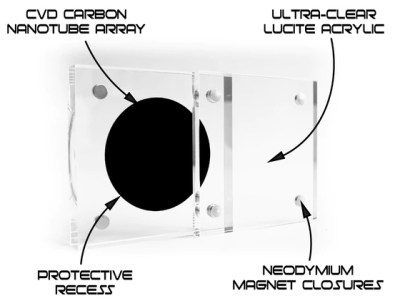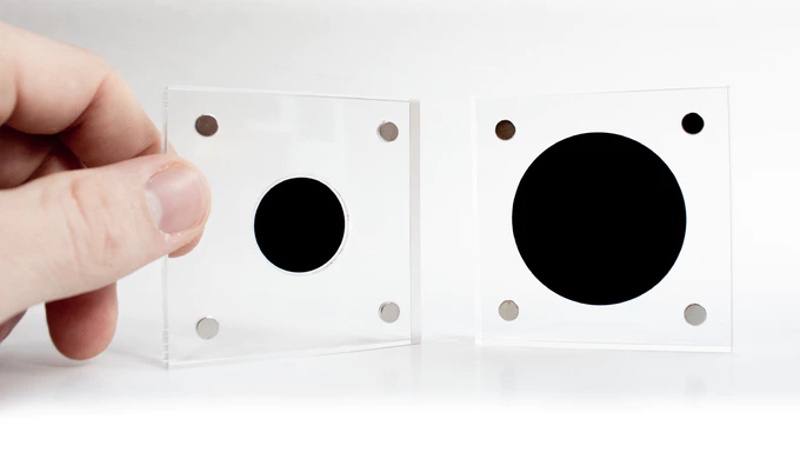If you thought “carbon nanotubes” were just some near-future unobtainium used in space elevators, don’t worry, you certainly aren’t alone. In reality, while the technology still has a way to go, carbon nanotube production has already exceeded several thousand tons per year and there are products you can buy today that are using this decidedly futuristic wonder material. Now there’s even one you can put in your pocket.
 Created by [Simon], a designer in the UK, this small carbon nanotube array is described as “A simulated black hole” because the surface absorbs 99.9% of the visible light that hits it. Protected by a clear acrylic case, the sample of the material makes a circle that’s so black it gives the impression you’re looking into deep space. Unfortunately, no time-dilating gravitational forces are included at any of level of support in the ongoing Kickstarter campaign; but considering it was 100% funded in just a few hours, it seems like most people are OK with the trade-off.
Created by [Simon], a designer in the UK, this small carbon nanotube array is described as “A simulated black hole” because the surface absorbs 99.9% of the visible light that hits it. Protected by a clear acrylic case, the sample of the material makes a circle that’s so black it gives the impression you’re looking into deep space. Unfortunately, no time-dilating gravitational forces are included at any of level of support in the ongoing Kickstarter campaign; but considering it was 100% funded in just a few hours, it seems like most people are OK with the trade-off.
[Simon] is well aware of the ongoing war between different methods of creating the “Blackest Black”, and he thinks he’s put his money (and by extension, his backer’s) money on the winner. Singularity is using a similar technology to the exclusively-licensed Vantablack, rather than a super-dark paint like “Black 3.0”. In fact he’s so confident that Singularity will appear darker than Black 3.0 that he mentions a head-to-head comparison is currently in the works.
If there’s a downside to the carbon nanotube array used in Singularity, it’s that you can’t actually touch it. [Simon] warns that while the acrylic case is only held together with magnets and can be opened for more careful inspection, actually touching the surface is absolutely not recommended. He says that even dust getting on the material is going to adversely effect its ability to absorb light, so you should really keep it buttoned up as much as possible.
While the Singularity looks like an interesting way to experience near perfect blackness, the concept itself is far from a novelty. A material that can absorb essentially all the light that hits it has important scientific, military, and of course artistic applications; so figuring out how to pull it off has become a pretty big deal.
















Interesting fact: a box with a hole and black insides works even better
https://www.youtube.com/watch?v=JoLEIiza9Bc
When I saw a picture of vanta black, my initial reaction was to interpret it as a hole, so there is nothing surprising about achieving this with a hole.
“while the acrylic case is only held together with magnets and can be opened for more careful inspection, actually touching the surface is absolutely not recommended.”
I can’t imagine breathing carbon nanotube dust is going to be great for you either.
Possible carcinogen, depends on the exact diameter and length of the nanotubes, even the end caps or lack thereof. I’d pass on that without a 100% valid MSDS for the item.
There is no evidence to support this, nanotubes are inherently very stable and have not been implicated in this way in any study. I accept anything is ‘a possible carcinogen’, but please be more scientific in these forums.
I was tempted to back this just to have a little piece of some of the ultrablack material as a display piece, but the kickstarter project hardly goes into any detail about what it is and how it’s made – suspicious flag #1.
Instead it’s going on about what black holes are without ever mentioning that a real black hole would bend light around it, becoming “invisible” except for the distortion around it – suspicious flag #2
Yeah, giving this a hard pass…
Same here. There is a fancy formular in the text alongside fancy pictures of a galaxy…
Had I seen this some years ago, I’d totally backed it up. But now with reports of all kinds of mischief with kickstarter it looks way too suspicious for me.
Too sad, I like the product they offer.
Well to help the other people who, I guess didn’t actually read the text, that formula has nothing to do with the material but adds to the marketing gumpf around black holes (which is to add to the creator’s superlatives)…
“The formula written above is the centrepiece of our understanding of black holes and one of Hawking’s greatest achievements. It links thermodynamical quantities like entropy, represented by the capital S, to the physical properties of black holes (A= area). The remaining letters are universal constants; k is the Boltzmann constant, c is the speed of light, h-bar is the reduced Planck constant and G is the constant of universal gravitation.”
However, reading on a bit further in the text it does explain that:
“The surface of each singularity is constructed from a inorganic, carbon nanotube array…”
Even the HaD summary points out that it’s a carbon nanotube array which are a known thing:
https://en.wikipedia.org/wiki/Carbon_nanotube
There are a variety of ways to make them:
https://en.wikipedia.org/wiki/Synthesis_of_carbon_nanotubes
As to how the creator of the kickstarter is doing it could be viewed as “private” (he could just be buying carbon nanotube from a science materials supplier, sticking on a thin dusting to some plastic and putting on a massive markup in price compared to the cost of materials+labour).
“he could just be buying carbon nanotube from a science materials supplier, sticking on a thin dusting to some plastic and putting on a massive markup in price compared to the cost of materials+labour”
doesn’t work that way i’m afraid.
the “carbon nanotube array” has to be grown on the surface so all the nanotubes grow vertically like a forest. light gets trapped within this forest and adsorbed as heat, which is another reason why you don’t want to touch the “paint” either. because you’d change the direction the nanotubes lay and change how they reflect light.
Would be interesting to know how it is made if it is real. Making carbon nanotubes is not very difficult if you have the equipment to do it but the result does not look that black, more like pencil graphite. But the tubes need to have a quite high aspect ratio and proper alignment to get the ultra-black effect.
I would also expect an electron microscope photo of the resulting nanomaterial, it should also look quite out of this world.
I guess they make it by sprinkling the nanotubes to the glued surface of the acrylic in an electric field, which aligns them. Nanohedgehog. Can’t touch this, because the glue barely holds the nanotubes.
Yes, it looked sort of cool, until he started spouting pseudoscience about black holes. This just very efficient paint. Its a bit like painting a big yellow dot and saying, well this is basically the same as the sun
I agree that he should have gone into some detail as to how he is creating his nanotube array. That being said, there is a pretty high chance that he will deliver exactly what is advertised in the kickstarter, that is a black circle in plexiglass that you can do nothing with. If this is a scam, he probably got his hands on some vantablack and is using that to fill the circles. Can anyone here estimate a rough price to make a carbon nanotube array 25mm in diameter? that would probably give more indication if its a scam or just marketing bs that people are falling for.
It says right on the label CVD, tells you exactly how it’s made and it would be alot of work to make these individual forests. Chemical Vapor Deposition
You make some good points, but this project doesn’t seem too complicated, so they may be able to pull it off.
Distrusting kickstarters by default is probably the best policy, though.
If you want something that’s essentially the same thing, but almost free, do this: light a normal wax candle, and collect soot by placing a object directly in the cool middle of the flame. A piece of heat-resistant glass works great — even a wine bottle or microscope slide. It only takes a second or two, and you can build up a large area of deep black relatively quickly.
With a bit of practice you can keep the collecting surface cool enough to not burn off the soot, but warm enough that wax evaporating from the candle doesn’t condense. You end up with the blackest stuff you’re likely to see this side of nanotubes. Totally non-robust though – one touch and the surface is destroyed.
>99.9% of the visible light that hits it.
That’s not particularly black. Put it next to a white sheet of paper, and the contrast ratio is somewhere around 700:1
Or in other terms, an S11 of -30 dB.
My thoughts also Revolver around this sentence.
Of all radiation available around me, visible light is only in a small range of wavelengths. So what about absorbing all the rest, as real open space does?
For sake of simplicity we can leave out wavelengths greather than half the diameter of the black circles…
No longer wavelengths? Aw, dangit. I wanted to get some radio-black to make my antennas more efficient at absorbing ham radio frequencies!
Absorbing the radiation makes it a dummy load, not an antenna.
I will give a shout out to this company whom I have been working with to use some of their version in some optical test gear I am working on
https://www.nano-lab.com/optical-black-coatings.html
its expensive, but its available in the united states
lol. This thing reminds me of a short video. (just under 3 mins)
Sort of a “Wile E Coyote” bit of humor, but in an office setting.
https://www.youtube.com/watch?v=P5_Msrdg3Hk
Or this classic, from the movie, “Yellow Submarine”
https://youtu.be/EK0R272RjXI